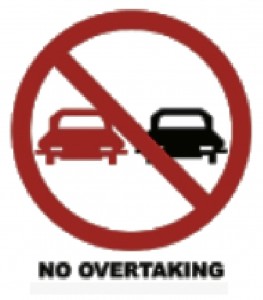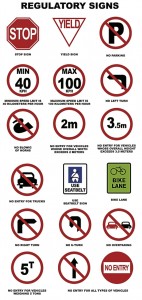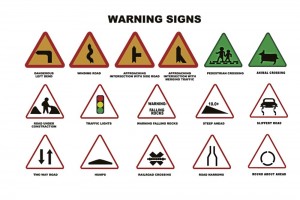
Commonly mistaken as “no double-parking,” “no overtaking” is usually complemented by a solid yellow line dividing the road.
Let’s face it, we women (and sometimes men) are suckers for the sign. How many times did you flip the coin to see if you’re going to go out with him or not? Or how many times did you have to consult the magic 8-ball to ask if he really loves you? Since the Dark Ages, there have been different forms of sign-seeking runes—crystal balls, tea leaves, candle drips, mirrors, tarot cards, etc.—which in my opinion are all faulty because human beings read them.
I have always believed that truth is subjective; but there are signs that are straightforward, such as road signs. I don’t think we can argue with the MMDA about the “one way” sign saying that in your city one means two or the “slippery when wet” sign means we should do a slalom. However, due to ignorance and of course the lack of maintenance and enforcement, we have not given importance to road signs while driving. This sometimes spells the difference between life and death on the road. A good example of this is the speed limit. Chicdrivers, I have listed the road signs you must know (especially if you like picking fights with the traffic enforcers).
Regulatory signs

These signs are usually self-explanatory and their position on the road, before a bridge, tunnel, etc., gives context clues on what they are. These include speed limits and weight limits on certain roads. Now you might think the speed limit is something that has a threshold of +3-5 km. Good luck with talking to the Skyway Patrol regarding your speeding ticket. I don’t think it works the same way as overweight baggage.
Warning signs
These signs usually predict what will happen if you don’t use your head. As Madam Auring or any other fortune-teller would say, “mayroon kang possibility ng 
Characteristics that will help you classify warning signs are they are usually triangular in shape and have a red band that outlines them. There are, however, green versions, which are for pedestrian and animal crossings.
Information signs
Although some of them come as dilapidated as dilapidated goes, it does not mean the rules do not apply. Some of these signs are so hard to read, not because your future is hazy but because they are poorly placed or not maintained (sometimes covered by a tree or bent because somebody tried to steal them.) Nevertheless, we as chicdrivers should also rely on our gut feel or common sense to make sure our road is clear and nothing will come in between us and what we want.
For comments and suggestions, please e-mail me at jnt@chicdriven.com; like us on Facebook/chicdriven or follow us on Twitter @chicdriven.

